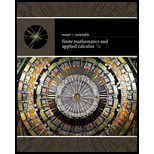
Concept explainers
In Exercises 1–8, use Bayes’ theorem or a tree diagram to calculate the indicated probability. Round all answers to four decimal places. [HinT: See Quick Example 1 and Example 3.]
Want to see the full answer?
Check out a sample textbook solution
Chapter 8 Solutions
Finite Mathematics and Applied Calculus (MindTap Course List)
- d. Find E(x) and practically interpret this value. Age (years) to Buy 1st Smart Speaker Probability3 0.024 0.025 0.016 0.017 0.028 0.049 0.0410 0.0911 0.0712 0.0713 0.0714 0.0615 0.0416 0.1517 0.1418 0.15arrow_forwardTest scores for random samples of students from two different schools were recorded. Test the claim that the standard deviation of test scores were students from school A is different from the standard deviation of test scores for students from school B. How many populations? 01 What is the parameter? O Difference between Means O Mean O Variance O Proportion O standard Deviationarrow_forwardTABLE 3: Number of packs with X number of RED candy x (Red Candy) 7 8 9 10 11 Total f (Pack) 3 5 3 3 1 15 Based on Table 3, find the probability that the number of red candy is: Less than the mean of X More than or equal to the mean of X Between and (E (X) - 1) and (E (X) + 1)arrow_forward
- Section: Functions of random variables Q: Let X and Y be random variables such that E[X] = 2 and E[Y] = 3 . a. Find E[4X + 5Y] . b. Find E[4X - 5Y + 2] .arrow_forwardYou have the following data Y=12, 8,16, 7, 8, 9, 20,4 The Skew modulus isarrow_forwardJ and K are independent events. P(J | K) = 0.93. Find P(J) %3D P(J)% = Hint: Independent Events Video on Independent Events +1 Submit Question 17,214 4. NOV 17 étv 3D MacBook Airarrow_forward
- find the probability that the number of the red candy is between(E(X)-1) and (E(X)+1)arrow_forward2.92 Suppose the diagram of an electrical system is as given in Figure 2.10. What is the probability that the system works? Assume the components fail inde- pendently. 0.95 A 0.7 B 0.8 C 0.9 D Figure 2.10: Diagram for Exercise 2.92.arrow_forwardRecall the given data. Quality (x) 1 2 Quality (x) 3 Total 1 2 3 Total f(1, 1) = = f(2, 1) = Meal Price (y) f(3, 1) = 1 45 36 9 Each probability f(x, y) will be calculated using the formula below. f(x, y) = number of times x and y occur at the same time total Note that the values along the bottom row and right most column will sum to 1. We are given that a total of 300 restaurants were evaluated. There are 45 instances for a quality rating of x = 1 and a meal price rating of y = 1. Use the given data to complete the table of probabilities. 2 1 42 45 300 3 Total 3 90 57 66 159 12 30 90 111 99 300 51 Meal Price (y) f(1, 2) = f(2, 1) = f(3, 2) = 2 f(1, 3) = f(2, 3) = f(3, 1) = 3 Total 1.00arrow_forward
 Glencoe Algebra 1, Student Edition, 9780079039897...AlgebraISBN:9780079039897Author:CarterPublisher:McGraw Hill
Glencoe Algebra 1, Student Edition, 9780079039897...AlgebraISBN:9780079039897Author:CarterPublisher:McGraw Hill
